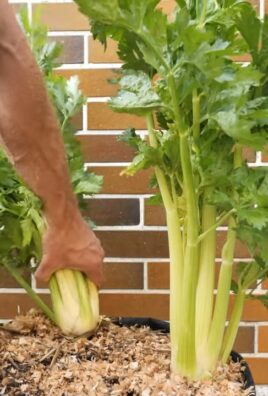Growing Bitter Melon might seem daunting, but trust me, with a few clever tricks and a little DIY spirit, you can harvest this unique and nutritious vegetable right in your own backyard! Have you ever dreamt of impressing your friends with a homegrown ingredient that adds a distinctive, slightly bitter, yet incredibly healthy twist to your dishes? Well, stop dreaming and start planting!
Bitter melon, also known as bitter gourd or karela, has a rich history, deeply rooted in Asian and African cultures. For centuries, it’s been celebrated not only for its culinary uses but also for its medicinal properties. From traditional Ayurvedic practices to modern-day health enthusiasts, the benefits of bitter melon are widely recognized.
But why should you bother with growing bitter melon? Well, store-bought varieties can sometimes be expensive and lack the freshness of homegrown produce. Plus, let’s be honest, there’s a certain satisfaction that comes from nurturing a plant from seed to table. This DIY guide will equip you with simple, effective techniques to overcome common challenges and maximize your yield. I’m going to share my favorite hacks for growing bitter melon successfully, even if you’re a beginner gardener. Get ready to unlock the secrets to a bountiful harvest and enjoy the unique flavor of this amazing vegetable!

Growing Bitter Melon: A DIY Guide to a Bountiful Harvest
Okay, so you’re thinking about growing bitter melon? Awesome! It’s a unique and rewarding plant to cultivate, plus it’s packed with health benefits. Don’t let the “bitter” part scare you off; there are ways to manage the flavor, and the satisfaction of growing your own is totally worth it. I’m going to walk you through everything you need to know, from seed to harvest.
Choosing Your Bitter Melon Variety
First things first, let’s talk varieties. There are a few different types of bitter melon, and they vary in size, shape, and bitterness.
* Chinese Bitter Melon: These are usually longer and lighter green, with smoother skin. They tend to be less bitter than other varieties.
* Indian Bitter Melon: These are smaller, darker green, and have a more bumpy, ridged skin. They’re known for their intense bitterness.
* Japanese Bitter Melon (Goya): Similar to Indian varieties, but often slightly larger.
I personally prefer the Chinese varieties because they’re a bit more forgiving on the palate. But hey, if you’re a fan of intense bitterness, go for the Indian or Japanese types!
Getting Started: Seed Germination
Bitter melon seeds have a tough outer shell, so we need to give them a little help to germinate. Here’s how I do it:
1. Scarification: Gently nick the seed coat with a nail file or sandpaper. Be careful not to damage the inner part of the seed! This helps water penetrate and speeds up germination.
2. Soaking: Soak the seeds in warm water for 24-48 hours. This further softens the seed coat and encourages sprouting. I usually change the water every 12 hours.
3. Planting: Fill small pots (about 3-4 inches in diameter) with a well-draining potting mix. Plant the seeds about ½ inch deep.
4. Warmth and Moisture: Keep the soil consistently moist but not soggy. Place the pots in a warm location (around 75-85°F). A heat mat can be really helpful if you live in a cooler climate.
5. Patience: Germination can take anywhere from 7-21 days, so be patient! Once the seedlings emerge, provide them with plenty of sunlight.
Transplanting Your Seedlings
Once your seedlings have developed a few sets of true leaves (usually after 2-3 weeks), they’re ready to be transplanted into their final growing location.
1. Choosing the Right Spot: Bitter melon needs full sun (at least 6-8 hours of direct sunlight per day) and well-drained soil.
2. Soil Preparation: Amend the soil with plenty of compost or well-rotted manure. Bitter melon is a heavy feeder, so rich soil is essential. I also like to add a slow-release fertilizer at this stage.
3. Spacing: Space the plants about 2-3 feet apart. They’ll need room to spread out and climb.
4. Transplanting: Gently remove the seedlings from their pots and plant them in the prepared soil. Water them thoroughly after transplanting.
5. Trellising: Bitter melon is a vine, so it needs a trellis or other support to climb on. You can use a fence, an arbor, or even a simple DIY trellis made from bamboo stakes and twine. I’ve even seen people use old ladders!
Caring for Your Bitter Melon Plants
Now that your plants are in the ground, it’s time to focus on providing them with the care they need to thrive.
* Watering: Water regularly, especially during hot, dry weather. Bitter melon needs consistent moisture, but avoid overwatering, which can lead to root rot. I usually water deeply a couple of times a week, rather than shallowly every day.
* Fertilizing: Feed your plants every 2-3 weeks with a balanced fertilizer. You can also use a liquid seaweed or fish emulsion fertilizer.
* Pruning: Pruning isn’t strictly necessary, but it can help improve air circulation and encourage fruit production. I usually remove any yellowing or dead leaves, as well as any suckers that grow from the base of the plant.
* Pest and Disease Control: Keep an eye out for common pests like aphids, spider mites, and squash bugs. You can usually control these pests with insecticidal soap or neem oil. Bitter melon can also be susceptible to fungal diseases like powdery mildew. To prevent these diseases, ensure good air circulation and avoid overhead watering. If you do notice signs of disease, treat with a fungicide.
Pollination: Helping Nature Along
Bitter melon has separate male and female flowers. The female flowers have a small, immature fruit behind them, while the male flowers do not. Sometimes, pollination can be a challenge, especially if you don’t have many bees or other pollinators in your garden.
* Hand-Pollination: If you’re not seeing much fruit set, you can try hand-pollinating the flowers. Use a small paintbrush to transfer pollen from the male flowers to the female flowers. Do this in the morning, when the flowers are open.
Harvesting Your Bitter Melon
The moment you’ve been waiting for! Harvesting bitter melon is all about timing.
1. Timing: Harvest the fruits when they are still green and firm, but have reached their mature size. The size will vary depending on the variety you’re growing. If you wait too long, the fruits will turn yellow or orange and become very bitter.
2. Cutting: Use a sharp knife or pruners to cut the fruit from the vine. Leave a short stem attached to the fruit.
3. Handling: Handle the fruits gently to avoid bruising.
Reducing Bitterness: Tips and Tricks
Okay, let’s address the elephant in the room: the bitterness! Here are a few things you can do to reduce the bitterness of your bitter melon:
* Harvest Early: As mentioned earlier, harvesting the fruits when they are still young and green will help reduce bitterness.
* Salting: Slice the bitter melon and soak it in salted water for 30 minutes before cooking. This helps draw out some of the bitter compounds.
* Blanching: Blanch the sliced bitter melon in boiling water for a few minutes before cooking. This also helps reduce bitterness.
* Pairing with Strong Flavors: Cook bitter melon with strong flavors like garlic, ginger, chili peppers, or soy sauce. These flavors can help mask the bitterness.
* Choosing the Right Variety: As I mentioned earlier, Chinese varieties tend to be less bitter than Indian or Japanese varieties.
Storing Your Harvest
If you’re not planning to use your bitter melon right away, you can store it in the refrigerator for up to a week. Wrap it in plastic wrap or place it in a plastic bag to prevent it from drying out.
Enjoying Your Bitter Melon
There are countless ways to enjoy bitter melon! Here are a few of my favorites:
* Stir-fries: Bitter melon is a popular ingredient in stir-fries. It pairs well with beef, chicken, pork, or tofu.
* Soups: Add bitter melon to soups for a unique flavor.
* Salads: Thinly sliced bitter melon can be added to salads.
* Juices: Bitter melon juice is a popular health drink.
* Stuffed Bitter Melon: Hollow out the bitter melon and stuff it with a mixture of ground meat, vegetables, and rice.
Troubleshooting: Common Problems and Solutions
Even with the best care, you might encounter some problems while growing bitter melon. Here are a few common issues and how to address them:
* Poor Germination: If your seeds aren’t germinating, make sure they’re warm enough and that the soil is consistently moist. You can also try scarifying the seeds more aggressively.
* Yellowing Leaves: Yellowing leaves can be a sign of overwatering, underwatering, or nutrient deficiency. Adjust your watering schedule and fertilize your plants regularly.
* Lack of Fruit: If your plants are flowering but not producing fruit, it could be due to poor pollination. Try hand-pollinating the flowers.
* Pest Infestations: Keep an eye out for common pests and treat them promptly with insecticidal soap or neem oil.
* Fungal Diseases: Ensure good air circulation and avoid overhead watering to prevent fungal diseases. If you do notice signs of disease, treat with a fungicide.
Final Thoughts
Growing bitter melon can be a challenging but ultimately rewarding experience. With a little patience and care, you can enjoy a bountiful harvest of this unique and nutritious vegetable. Don’t be afraid to experiment with different varieties and cooking methods to find what works best for you. Happy gardening!

Conclusion
So, there you have it! Growing bitter melon doesn’t have to be a daunting task. With a little patience, some simple DIY ingenuity, and the right conditions, you can cultivate your own supply of this nutritious and unique vegetable right in your backyard or even on your balcony. This DIY trick, focusing on creating a supportive trellis system using readily available materials, is a game-changer for several reasons.
Firstly, it maximizes space. Bitter melon vines are vigorous climbers, and without proper support, they’ll sprawl across the ground, taking up valuable real estate and increasing the risk of disease. Our DIY trellis method allows the vines to grow vertically, making the most of your available space, whether you have a sprawling garden or a compact urban balcony.
Secondly, it improves air circulation. By lifting the vines off the ground, you’re promoting better airflow around the leaves and fruits. This helps to prevent fungal diseases, which are a common problem for bitter melon plants, especially in humid climates. A well-ventilated plant is a healthier plant, and a healthier plant produces more delicious bitter melons.
Thirdly, it makes harvesting easier. No more bending over and searching through tangled vines to find your precious bitter melons! With a vertical trellis system, the fruits are easily accessible, making harvesting a breeze. You’ll be able to spot them quickly and harvest them at the perfect stage of ripeness.
But the beauty of this DIY approach lies in its adaptability. Feel free to experiment with different materials for your trellis. Bamboo poles, repurposed metal fencing, or even sturdy branches can all be used to create a supportive structure. You can also adjust the size and shape of the trellis to fit your specific needs and space constraints. Consider adding companion plants like basil or marigolds around the base of your bitter melon to deter pests and attract beneficial insects. Another variation is to try different training techniques. Gently guide the vines as they grow, encouraging them to spread evenly across the trellis for optimal sunlight exposure.
Don’t be afraid to get creative and personalize your bitter melon growing experience!
We’ve found that using old pantyhose or soft cloth strips to gently tie the vines to the trellis works wonders, preventing damage to the delicate stems. Also, remember to regularly prune your bitter melon vines to encourage branching and fruit production. Removing any yellowing or diseased leaves will also help to keep your plants healthy.
Growing your own bitter melon is not only rewarding but also a sustainable way to enjoy this unique vegetable. You’ll have complete control over the growing process, ensuring that your bitter melons are free from harmful pesticides and chemicals. Plus, there’s nothing quite like the taste of a freshly harvested, homegrown bitter melon.
So, what are you waiting for? Give this DIY trick a try and experience the joy of growing your own bitter melon. We’re confident that you’ll be amazed at the results. And don’t forget to share your experiences with us! We’d love to see your DIY trellis creations and hear about your bitter melon growing adventures. Share your photos and tips on our social media pages using #DIYBitterMelon or leave a comment below. Let’s build a community of passionate bitter melon growers! We are eager to see how you implement this **bitter melon** growing technique.
Frequently Asked Questions (FAQ)
What is the best time of year to plant bitter melon?
Bitter melon thrives in warm weather, so the best time to plant it is in late spring or early summer, after the last frost. The soil temperature should be at least 65°F (18°C) for optimal germination. In warmer climates, you can even plant it in early fall for a winter harvest.
How much sunlight does bitter melon need?
Bitter melon requires at least 6-8 hours of direct sunlight per day. Choose a sunny location in your garden or on your balcony to ensure healthy growth and abundant fruit production. If you’re growing it indoors, supplement with grow lights if necessary.
What kind of soil is best for bitter melon?
Bitter melon prefers well-drained, fertile soil with a slightly acidic to neutral pH (6.0-7.0). Amend your soil with compost or other organic matter to improve drainage and fertility. Avoid heavy clay soils, as they can become waterlogged and lead to root rot.
How often should I water bitter melon?
Water bitter melon regularly, especially during hot and dry weather. Keep the soil consistently moist, but avoid overwatering, which can also lead to root rot. Water deeply at the base of the plant, rather than overhead, to prevent fungal diseases. A good rule of thumb is to water when the top inch of soil feels dry to the touch.
How often should I fertilize bitter melon?
Fertilize bitter melon every 2-3 weeks with a balanced fertilizer, such as 10-10-10. You can also use organic fertilizers, such as compost tea or fish emulsion. Avoid over-fertilizing, as this can lead to excessive vegetative growth and reduced fruit production. During the flowering and fruiting stage, you can switch to a fertilizer that is higher in phosphorus and potassium to promote fruit development.
What are some common pests and diseases that affect bitter melon?
Common pests that affect bitter melon include aphids, spider mites, and squash bugs. You can control these pests with insecticidal soap, neem oil, or by handpicking them off the plants. Common diseases include powdery mildew, downy mildew, and fusarium wilt. Prevent these diseases by providing good air circulation, avoiding overhead watering, and using disease-resistant varieties. If you notice any signs of disease, treat the plants with a fungicide.
How long does it take for bitter melon to mature?
Bitter melon typically takes 60-90 days to mature after planting. The fruits are ready to harvest when they are still green and firm. If you wait too long, they will turn yellow and become bitter. Harvest the fruits regularly to encourage continued production.
How do I know when to harvest bitter melon?
Harvest bitter melon when the fruits are still green and firm, before they start to turn yellow or orange. The size of the fruit will vary depending on the variety, but generally, they should be about 6-10 inches long. Use a sharp knife or scissors to cut the fruit from the vine, leaving a short stem attached.
Can I grow bitter melon in a container?
Yes, you can grow bitter melon in a container, but you’ll need a large container (at least 10 gallons) with good drainage. Use a well-draining potting mix and provide a trellis or other support for the vines to climb. Container-grown bitter melon may require more frequent watering and fertilizing than plants grown in the ground.
How do I save seeds from bitter melon?
To save seeds from bitter melon, allow a few fruits to fully ripen on the vine until they turn yellow or orange. Once the fruits are ripe, cut them open and scoop out the seeds. Wash the seeds thoroughly and spread them out on a paper towel to dry. Once the seeds are completely dry, store them in an airtight container in a cool, dark place.
What are some ways to cook with bitter melon?
Bitter melon can be cooked in a variety of ways, including stir-frying, steaming, boiling, and stuffing. It is often used in Asian cuisine, particularly in Indian, Chinese, and Filipino dishes. To reduce the bitterness, you can soak the sliced bitter melon in salted water for 30 minutes before cooking.
Is bitter melon good for you?
Yes, bitter melon is a very nutritious vegetable. It is a good source of vitamins A and C, as well as iron and potassium. It is also believed to have medicinal properties, including helping to regulate blood sugar levels and boost the immune system. However, it is important to note that bitter melon can interact with certain medications, so it is best to consult with your doctor before consuming it regularly.




Leave a Comment